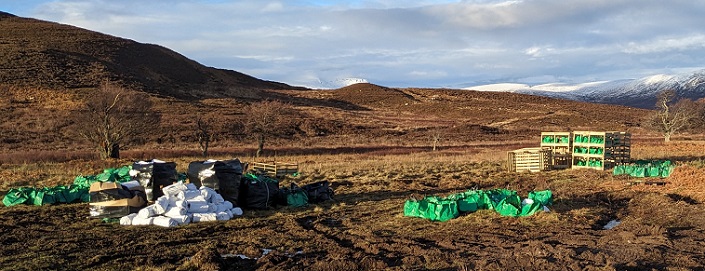
Ten days ago tree nurseries were in the news (see here) when Christie’s of Fochabers were quoted as claiming “We will have to burn millions of trees after cuts” as a result of the Scottish Government deciding to cut funding for tree planting by 44% to £45.4m next year. The BBC quoted Mr Christie, the owner of Christies of Fochabers, as describing the cuts as an “absolute shocker” and “We’ve been encouraged to grow trees by the government to reach this target of 18,000 hectares.”
Unsurprisingly, Mr Christie failed to mention of the Woodland Carbon Code which was intended to drive private investment in nature. It would appear from his nursery owner’s viewpoint that the Woodland Carbon Code and the market it was supposed to be create is of little relevance when it comes to driving demand for the trees grown by his business. That is supported by the evidence of what has been going on in the Cairngorms National Park with BrewDog’s Lost Forest, for example, almost entirely financed by Scottish Forestry grants (see here). If the carbon market was working as intended Mr Christie wouldn’t be claiming that his nursery may need to rip up 10 million trees in the next few weeks.
What neither Mr Christie nor the BBC pointed out is that the Scottish Government has not just been
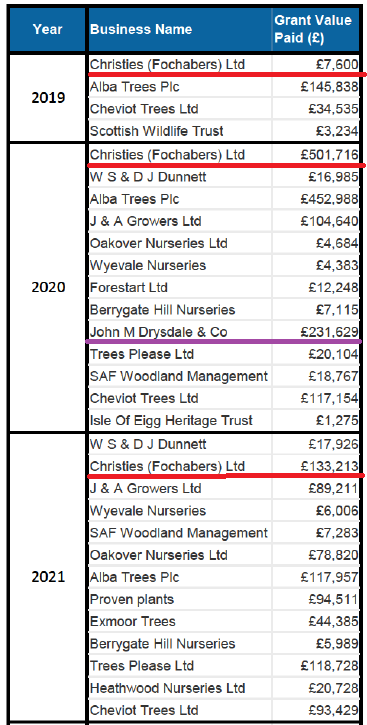
heavily subsidising the demand side through the grants system, it has also been subsiding the supply side (see table on left). In the case of Christie’s nursery that came to over £640k in three years.
This shows the Scottish Government has effectively been providing a double subsidy to many tree planters. The subsidy to nurseries enables trees to be sold below the true cost of growing them while forestry grants then cover much of the purchase and planting costs. Despite all the lavish subsidies, somehow the Scottish Government never meets its tree planting targets.
While the BBC reported “Ministers blame the decision [to slash grants] on cuts its block grant from the UK government”, actually they should see this an opportunity. We should move away from relying on tree planting and all the damage it causes to enabling forests to regenerate naturally as happens in many other countries of the world.
Incidentally, there were no less than 997 comments on the BBC article the most popular of which (131 likes) said “planting trees has become a useless box ticking exercise”!
Akre and its tree nursery, abrdn and Far Ralia
First, a brief recap of the relationships (see here). John MacDonald Drysdale is the father of Renwick Drysdale, the Managing Director of Akre Ltd, a “natural capital consultancy” which also operates akre trees. Renwick Drysdale helped to advise abrdn on its acquisition in 2021 of 1,500 ha of land, now known as Far Ralia, from his uncle, Alastair Findlay and the Trustees of Eira Drysdale who owned the Ralia estate. His father, John M Drysdale was also a trustee of the estate and is now a director and shareholder in Akre Ltd. Akre has subsequently been heavily involved in the “restoration” of Far Ralia (see here for their own account of this).
Scottish Forestry has confirmed that its grant for £231,629 to John M Drysdale and Co in 2020 (underlined in purple in table above) was transferred with their agreement to Kilrie Trees which then changed its name to Akre Ltd after its new one acre nursery:
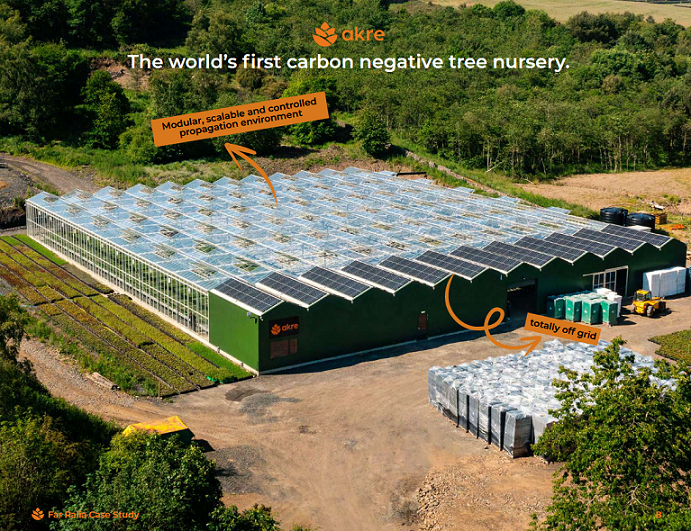
Scottish Forestry have also confirmed their £231,629 grant to Drysdale/Kilrie/Akre was paid in full in 2022 and broken down as follows:

A news item on Farming Online on 10th August 2022 about Akre (see here) omitted to mention the Scottish Forestry grant and claimed the nursery was “created following a £2m private funding package”. By contrast, a press release from Scottish Forestry (see here) on 13th June 2023, the day the Cabinet Secretary for Rural Affairs Mairi Gougeon visited the Akre nursery, suggests that it “would not have been possible without the considerable support from the Scottish Government”. More recently, in October 2023, an article in Scottish Business News reported the original (unnamed) private investors have been re-paid and their investment replaced by a £2.5m loan from Virgin Money (see here).
The Scottish Government’s Rural Payments “harvesting and processing” page (see here) sets out the criteria and points system which is used as ‘the basis for allocating funding on a competitive basis through the Forestry Grant Scheme clearing process”. This points system appears to favour larger nurseries and those with contracts in place for larger tree sales: an application gets three points “where you have agreements/contracts/evidence to produce over 1 million trees/year”and five points “where you have agreements/contracts/evidence to produce over 5 million trees/year”.
Information from each of the six contracts for the six grants obtained from Scottish Forestry suggest that the Drysdales’ original intention was that the new tree nursery should focus initially on growing Sitka spruce, for which there was greatest demand:

The information in the contracts, however, is far from clear as there are also references to growing native trees and the extract below suggests the initial split would be 50% Sitka spruce, 50% native trees:
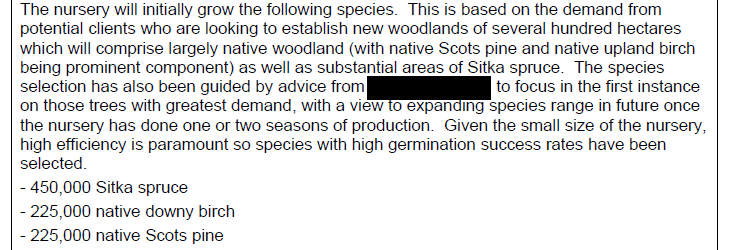
Whatever actually happened, according to the article in Scottish Business News “native species of oak and ash, Scots pine, silver birch, wild cherry, rowan, and alder” now “make up more than 98% of the akre nursery output”. If correct, it appears Akre have moved completely away from growing Sitka spruce. The breakdown between these native species is not given in the news story but if the akre nursery is using its own trees to plant for abrdn, according to the Far Ralia Forest Plan the majority are likely to be Scots pine and birch. These species, like Sitka spruce, can regenerate naturally in profuse quantities and, with the will, this could be done at a fraction of the cost to the public purse.
Besides the shift in species grown, akre appears to have been rapidly expanding production at its nursery. The first contract extract above shows akre was talking about “ramping up production to 1.8m trees but last Autumn they were telling Scottish Business News (link above) that they were intending to increase production to 6.4m trees by 2025.
The table showing grants awarded to tree nurseries suggests that Scottish Forestry has mainly been supporting tree production on larger nurseries producing common species which readily regenerate naturally. The policy justification for this, both in terms of finance and the natural environment, is unclear but the impression is that Scottish Forestry may have been so desperate to meet its planting targets set by the Scottish Government that it has ceased to care about what is planted or by whom.
There is further evidence for that interpretation in the governance arrangements around the award of the contracts to John M Drysdale and Co. Scottish Forestry rightly requires tree nursery applicants to provide evidence of future demand in the form of letters/assurances from potential future customers. While such letters are likely to say similar things, the chances of them being identically worded must be infinitesimal but that is what happened in this case:
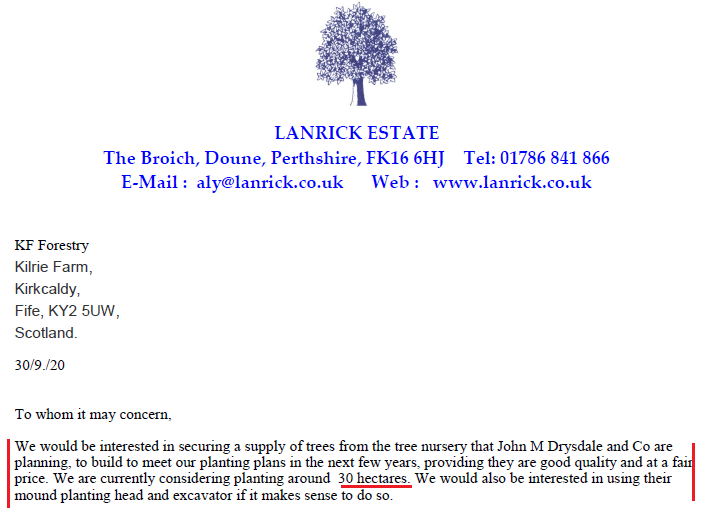
The paragraphs are laid out slightly differently but identically worded – including the grammatical error “planning, build” – except for the underlined words which give the extent of the planting.
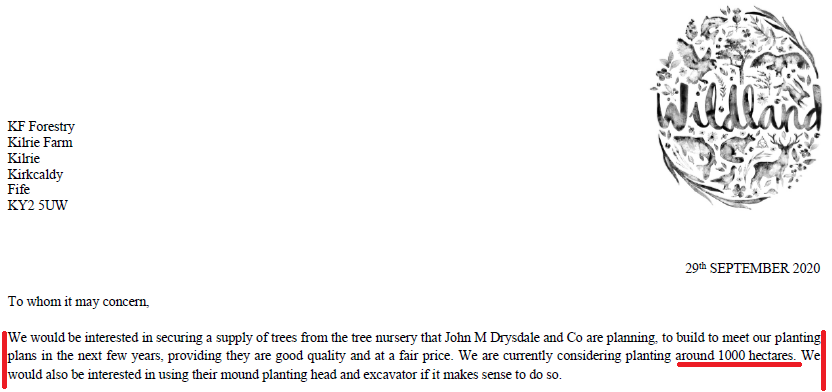
It is not clear from the wording “to whom it may concern” whether applicants were made fully aware their letters would be used as a reference which would be on to passed on to Scottish Forestry. If they were, why wouldn’t they have addressed the letters to Scottish Forestry and sent them directly?
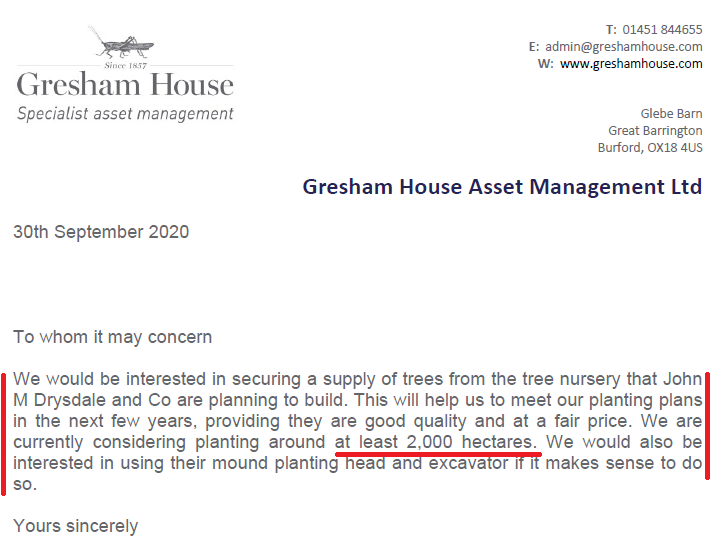
It is worth noting the implications of “providing they are………….at a fair price”. Scottish Forestry’s grants to akre would enable it to supply trees at a cheaper price than would be otherwise possible.
So why did Scottish Forestry accept these identical references without apparently questioning them? Were its staff so busy that they paid no attention to the content or were they under such pressure from senior management that basic governance arrangements were ignored?
Under Scottish Forestry’s grant funding rules the maximum they will pay for nurseries is 40% towards the cost of capital equipment and the rest needs to come from private sources (i.e not grants from other agencies, the lottery etc):

This suggests that the initial private investment in the Akre nursery which was replaced by a loan from Virgin Money may have come from John M Drysdale and Co. Unfortunately, the two sets of abbreviated accounts filed by Akre Ltd to date do not show the source of the original investment. This is relevant because John M Drysdale also made the following declaration in their application:
It is unclear why John M Drysdale and Co was able to supply the match funding (knowing who provided it would help) but declared it was unable to afford the remaining investment without Scottish Government funding. It is also unclear what criteria Scottish Forestry uses to assess affordability and whether it conducts an independent assessment of an applicant’s means to decide objectively whether they could afford the investment without SRDP funding. This could help explain why they awarded over £640k to Christie’s over three years when, according to Companies House, that company appears to have net assets of over £6 million.
Grants to tree nurseries – the case for reform
This post has provided an illustration of how a large proportion of tree planting in Scotland appears totally dependant on public subsidy, not just on the demand side but on the supply side and this effectively gives landowners a double subsidy. The planting at Far Ralia in the Cairngorms National Park provides a good example of how this operates. Abrdn Property Holdings (APH) Ltd, the company that owns Far Ralia and which is registered in the tax haven of Guernsey, is receiving Scottish Forestry grants to plant trees most of which have been grown in a tree nursery that has also received Scottish Forestry grant funding. The result is that so-called green investors like the Abrdn Property Income Trust, which controls APH, are able to harvest public money to plant trees with very little cost to themselves. This subsidy system has been helping to pump prime the massive recent increases in land prices in Scotland making land even more unaffordable for most.
The double subsidy system also benefits companies like Akre Ltd which are subsidised by Scottish Forestry to grow trees in nurseries and then paid to plant them through further Scottish Forestry grants. The governance around this financial gravy train appears very weak and is not in the interests of the public but instead serves the interests of those who generally are already very rich. The family connections between Akre trees and the previous owners of Far Ralia are a case in point. The 40% cut in funding to Scottish Forestry’s grants budget should be taken as an opportunity to reform the whole rotten system.
The main reason the Forestry Grants system has survived so long is politicians mistaken belief that the only way to expand woodland in Scotland, to help mitigate climate change and reverse the collapse in nature, is to plant trees. This myth is fed by the vested interests of stalking estates, and the forestry industry as practiced currently in Scotland. In fact, as frequently argued on this blog (see here for example) natural regeneration would do the job in most places and for most tree species if deer numbers were reduced and sheep properly controlled. The main challenge for the Scottish Government therefore is how to do this and promote a new model of forestry similar to that practised on the continent where trees are rarely planted.
Moving from planting trees to natural regeneration as a means of restoring and expanding woodland would greatly reduce the need for industrial scale tree nurseries and for the species most commonly grown in them like Sitka spruce, Scots Pine and birch. These spread rapidly when grazing is reduced and there is little need to plant such species outside specific places, like some of the most intensively grazed glens in the borders. There would, however, be a continued need to grow trees for specialist purposes. Examples includes the need to plant the landslip prone slopes above our transport infrastructure (see here) and the potential to replace stock fences with hedges.
Demand for trees to be used for such purposes would be more than enough to keep Scotland’s tree nurseries busy for several years without digging up peaty soils to plant trees as BrewDog has done at its Lost Forest (see here) and akre is now doing at Far Ralia (further post coming soon!). It is time that both our National Park Authorities asked the Scottish Government to reform the Scottish Forestry grants system as a matter of urgency, with the money currently allocated to large tree nurseries to subsidise industrial levels of production and reduce costs to landowners being a key part of this.
The identical references were quite likely written by Scottish Forestry themselves, in answer to a question: “what would you like us to put in the reference?”